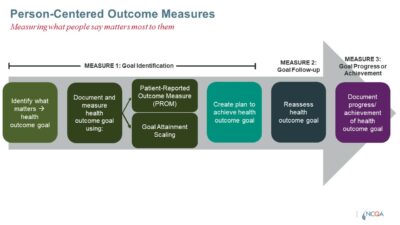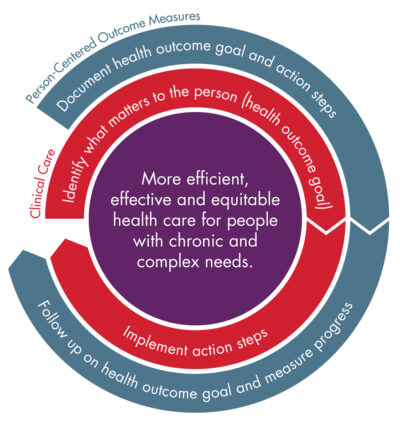Good to Know: Person-Centered Outcome Measures
August 22, 2022 · Andy Reynolds
An updated section of our website offers a step-by-step explanation of a new measures we’re developing: person-centered outcome (PCO) measures.
We’ve broken the PCO story into “chunks,” including:
- Person-Centered Outcomes: What are PCO measures, exactly?
- Building on Best Practices in Goal Setting: How do you measure what matters to people?
- Implementing Person-Centered Outcomes: How can we make PCO measures a reality?
- Measuring Quality for People with Complex Needs: Why are PCO measures important for people who need complex care?
- What’s Next: There are many ways to help in this work. Email us at pcomeasures@ncqa.org to find out how you can get involved.
Here are other things to know about patient-centered outcome measures.
PCO vs. PROM/Goal Attainment Scaling
The graphic below shows the relationship between:
- Person-centered outcome measures and
- Patient-reported outcome measures (PROMs) or its alternative, goal attainment scaling.

PCO measures are a trio or 3-step sequence:
- Goal Identification.
- Goal Follow-up.
- Goal Progress or Achievement.
Patient-reported outcome measures (PROMs) and goal attainment scaling are a decision point inside PCO Measure 1 (Goal Identification). When it’s time to document and measure a person’s care goals, clinicians can use either:
- A patient-reported outcome measure (PROM), or
- Goal attainment scaling.
In other words:
- PCO measures determine performance.
- A PROM or goal attainment scaling is a tool to document performance.
For other context about PROMs, see our previous posts:
- In Spring 2022, when CMS officials said they want 25% of quality measures to be patient-reported or patient-centered.
- About our Torda Fellows’ work on PROM—especially in 2019.
- In 2016, when we added a patient-reported depression measure to HEDIS.
Another View
The graphic to the right shows another way to think about PCO measures.

The PCO measures reinforce that incorporating a person’s voice into their care is a key step in achieving health equity.
The measures (shown in blue) work alongside clinical care (shown in red) to help people living with complex health needs make progress toward a health outcome goal that matters to them.
Efficient, effective and equitable care is at the center (in purple) as the purpose and result of PCO measures.
New, Yet Familiar
New and old ideas blend together in PCO measurement.
- Name Change: The idea of person-centered outcome measures may sound familiar. We called them person-driven outcome (PDO) measures for years. Clinicians and other colleagues convinced us that more people understand and prefer “person-centered outcome measures.” We changed the name but the underlying idea is the same.
- You’re Closer than You Think: Many clinicians already collect goals from the people they serve and put them into care plans. PCO measures standardize and structure that process to allow comparisons between sites and clinicians.
- Growing Interest: We’ve launched a learning collaborative to test the feasibility of PCO measures in primary care and long-term services and support settings. After behavioral health organizations found out about that work and expressed interest in PCO measurement, we set up a second collaborative for behavioral health. We are encouraged that what started as a project in one clinical area has spread to another. Look for news in 2023 on what we’ve learned from both collaboratives.
NCQA thanks the John A. Hartford Foundation and The SCAN Foundation for supporting our PCO work.







